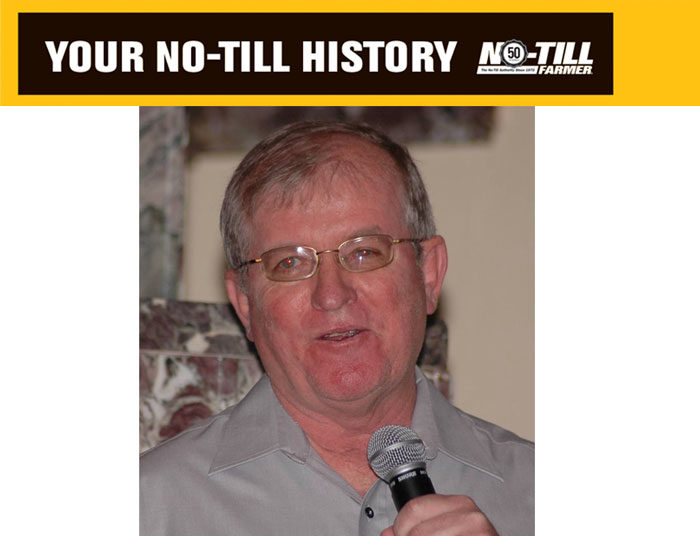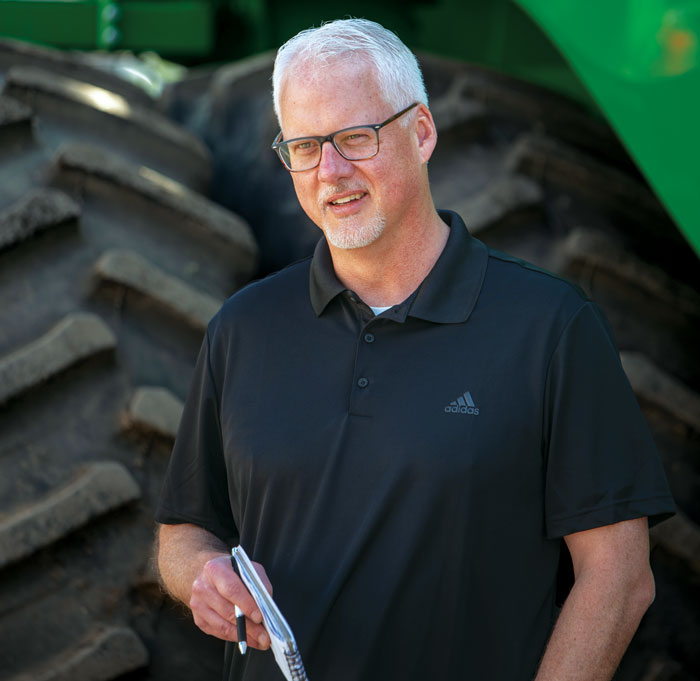It was 7 years ago this month that the no-till community lost one of its champions to cancer in Ohio farmer, Ohio State University extension educator and crop consultant Ed Winkle at age 65. A 1999 No-Till Innovator of the Year, Ed also served as an advisor to the National No-Tillage Conference (NNTC), wrote several articles and authored a special report on growing high-profit soybeans that continues to sell on our online store.
Through our research into the 60th anniversary of no-till in 2022 (something Ed would have thoroughly enjoyed), we found that the prolific no-till blogger’s material is still accessible online. He started the daily blog on a dare from wife LuAnn in 2007 (admitting he didn’t know what a blog was at the time). But the “never short of something to say” Winkle posted daily — and lived to see his blog record an amazing 3 million page views.
Even throughout his painful bout with cancer, Winkle was still writing and teaching right up to his passing — on topics such as nutrient loss through erosion, humid acids, and tips for young farmers.
Here is what my dad, Frank, has to say when he broke the news of his passing to staff and subscribers in April 2015. “I had many opportunities to work with Ed through both our conference and as a source for articles in No-Till Farmer. Ed had a big heart for farmers trying to solve no-till challenges, and he was always so willing to offer advice or suggestions because he wanted farmers to succeed with no-till. We’re going to miss Ed’s helpful spirit.”
Now, thanks to rediscovering his blog, Ed is still giving us ideas to follow up on that will help his fellow no-tillers.
Here is a story about his early exposure to no-till …
My No-Till Experience (January 19, 2009)
By Ed Winkle
My dad first started no-tilling in the mid seventies when the local White dealer brought a new White 5100 no-till planter to the farm. I was teaching ag 30 miles up the road and we were all looking for a better way to save soil on hilly farms and free up time to tend livestock and other jobs.
We had already switched from moldboard plowing to chisel plowing so it was a natural progression for us. We made lots of mistakes because we didn't understand what we were trying to do but we were willing to learn.
Our problem was weed control. We knew how to control weeds with plowing and disking but never understood how to control weeds with chemicals in no-till. We had 2,4-D and atrazine, enough to get started but had no idea what paraquat was or how it worked.
We quickly learned how to use it to kill what was there so the crop could get a start and control grasses and broadleafs somewhat with 2,4-D and atrazine.
We finally got the weeds under some control but always fought them. We had dear old Johnsongrass (I am sure there is a place in heaven for Johnson and his followers and those led down that washed around path somewhere) and there was no control for it.
We kept no-tilling corn through those years and finally got to raising soybeans for a cash crop. It really caught on with the oil embargo in the early 70's and we were forced to learn how to no-till soybeans when it did.
We drilled soybeans in plowed ground and there was no no-till drill so again farmer innovators developed the first no-till drills. This was years after planting no-till soybeans in 30 inch rows with the no-till corn planters.
The problem with the corn planter was the coulter. It would smear the damp soil so you had to wait for the soil to dry out before you could plant. By the time you waited you could plow and disk and get the corn planted and started growing. Drilled beans canopied faster than corn planted rows, too.
Case IH came out with the first good no-till row units and they caught on. The reduced inside diameter gauge wheel tire and low row unit pressure was key to their success. The first real no-till drill I ever used was the Haybuster and the Tye drills and it was 1990 by now.
In the 90's we had so much moisture in the Ohio Valley we had to wait forever it seemed to plant so I was ready to quit no-tilling by 1995. It so happened I bought my first modem for my IBM computer and found the Internet. A successful farmer near Dayton whom I had met during my stint as a county agriculture agent kept urging me to try it. There I found Crop Scouting on www.agriculture.com who were pioneers in the agricultural internet revolution we enjoy today.
I posed my dilemma on Crop Scouting and a farmer in Iowa told me to take the no-till coulters off and let the double disk opener do the tillage! I thought that would never work but was willing to try anything to keep the benefits of no-till on our soils.
Sure enough it worked but the row unit wasn't as good on the White as the Case IH. I bought an IH 400 Cyclo corn planter and had the best of both worlds but liked the easier-to-use vacuum seed mechanism on the White planter better. The drive to find the combined features of both was on so the farmer in Iowa worked with Howard Martin of Kentucky and his cousin, the local ag mechanic to perfect the IH row unit principles on Deere, Kinze and White planters.
Mr. Martin was working with Eugene Keeton of Tennessee who developed the famous Keeton Seed Firmer, a long plastic spoon that tucked seeds on corn planters at the bottom of the seed trench. This great invention is worthy on its own and deserves its own recognition.
This group came up with the Nu-Till setup adapted and promoted by AgSpectrum Company in Iowa. That partnership didn't last so Howard promoted his own Martin System thanks to the farmer and mechanic and others who quickly adapted the system and shared it with all who would listen. I was one of those and helped bring it to Ohio and across the land thanks to the agricultural Internet, email and talks we were invited to. We all learned together and shared our learning and pitfalls.
Today you find many innovative farmers using the Martin System of no-till planting which is any row unit with a single disk opener slicing the residue and applying nitrogen and sulfur, a Martin row cleaner sweeping the residue out of the way of the trench, the standard double disk opener doing the tillage by slicing a Vee for the seed so it can germinate and grow like any corn planting system.
The planter meters the seed into the seed tube where it is sensed and monitored, drops into the seed trench, pressed firmly into the trench and lightly tilled like a garden by a pair of Martin spiked closing wheels (smaller Martin row cleaners mounted to reverse action), leaving a seed trench gently lifted by the weight of the planter through the action of the reduced inside diameter gauge wheel tire, yet keeping the seed in its place at its desired depth and spacing by the planter. We strive to keep the same amount of soil and pore space with this system just like you do in normal planting of seeds. The row is topped off with a slight mound with crumbly loose soil with a 40 inch looped drag chain made of 3/8 inch heavy square steel running loosely behind the seed trench, attached to the planter to form this last tillage without bouncing up into the spiked closing wheels.
The result is the best corn planter I ever used and I know many farmers agree. This system has been out now since the mid nineties, catching on year by year giving farmers a tool to plant corn and other crops the first day you could drive a tractor over that field. This system allowed drenched Midwest soils to be planted first last year and many years giving the crop a chance to catch all the sunlight it possibly could in a no-till situation.
The NNTC or National No-Tillage Conference demonstrated its effectiveness again last week when many of the winners of various awards was found to be using this system now for many years. Corn yields keep going up in this country regardless of weather and this system allows it to happen in no-till too, saving "soil, oil and toil" when it is most needed and appreciated.
This is a part of my no-till learning over my lifetime and I thank the many people who helped make it so, "for others as well as myself" as the FFA Creed so aptly says from 1930.
Ed Winkle
Friends of Ed from NNTC and his many travels may enjoy some of his blogs, available here
We enjoyed seeing his collection again and it brought back fond memories. And also reminded us of some of Ed’s meaningful and encouraging words that would keep us mindful of how important our work is — in assembling the greatest minds in no-till to transfer the knowledge between farmers.
“The best think-tank in all agriculture,” he told me during a coffee break at the NNTC one year in Des Moines, as he scanned the crowd of attendees.
And as his friends, students and colleagues remember Ed 7 years later, you can bet he is remembering you, too. Here is another message on what you and his no-till friends meant to him, written in 2012 after a week spent at the NNTC .
Got your own Ed Winkle story? Leave it in the comment field below…
The 2024 No-Till History Series is supported by Calmer Corn Heads. For more historical content, including video and multimedia, visit No-TillFarmer.com/HistorySeries.








Post a comment
Report Abusive Comment